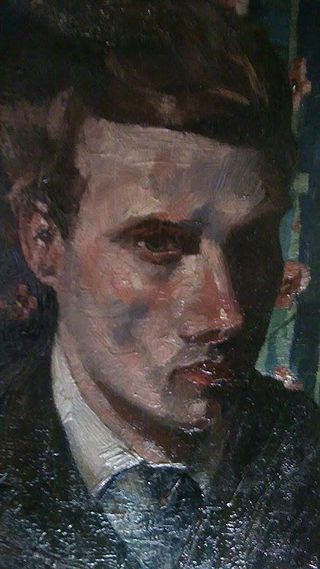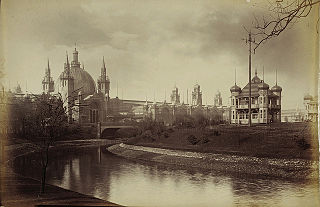
Glasgow is the most populous city in Scotland, located on the banks of the River Clyde in west central Scotland. The city is the third-most-populous city in the United Kingdom and the 27th-most-populous city in Europe. In 2020, it had an estimated population as a defined locality of 632,350 and anchored an urban settlement of 1,028,220.

The Hunterian is a complex of museums located in and operated by the University of Glasgow in Glasgow, Scotland. It is the oldest museum in Scotland. It covers the Hunterian Museum, the Hunterian Art Gallery, the Mackintosh House, the Zoology Museum and the Anatomy Museum, which are all located in various buildings on the main campus of the university in the west end of Glasgow.

Kelvingrove Park is a public park located on the River Kelvin in the West End of the city of Glasgow, Scotland, containing the Kelvingrove Art Gallery and Museum.

The Burrell Collection is a museum in Glasgow, Scotland, managed by Glasgow Museums. It houses the art collection of Sir William Burrell and Constance, Lady Burrell. The museum opened in 1983 and reopened on 29 March 2022 following a major refurbishment. It was announced as the winner of the Art Fund Museum of the Year in July 2023. It is the only non-national museum to be the outright winner twice.

The SEC Centre is Scotland's largest exhibition centre, located in Glasgow, Scotland. It is one of the three main venues within the Scottish Event Campus.

Whiteinch is an area in the city of Glasgow, Scotland. It is situated directly north of the River Clyde, between the Partick and Scotstoun areas of the city. Whiteinch was at one stage part of the burgh of Partick, until that burgh's absorption into the expanding city of Glasgow in 1912, and part of the Parish of Govan.

The Kelvin Hall, located on Argyle Street in the Yorkhill area of Glasgow, Scotland, is one of the largest exhibition centres in Britain and now a mixed-use arts and sports venue that opened as an exhibition venue in 1927. It has also been used as a concert hall, home to the Kelvin Hall International Sports Arena to 2014, and from 1988 to 2010, Glasgow's Museum of Transport. As part of the economic redevelopment of Greater Glasgow promoted by the Scottish Development Agency and local authorities to enhance the city's tourist infrastructure and to attract further national and international conferences, the Scottish Exhibition and Conference Centre was designed as the Hall's successor for exhibitions and entertainments, built in 1983 and opened on the nearby Queen's Dock in 1985 with an exhibition area equal in size to the Kelvin Hall but with the benefit of extensive car parks and land for other complementary buildings. The Hall is protected as a category B listed building, and is served by city bus services and by Kelvinhall subway station.

The West End Festival is an annual festival in the West End of Glasgow, Scotland.

Thomas John Honeyman was an art dealer and gallery director, becoming the most acclaimed director of Kelvingrove Art Gallery and Museum, Glasgow. Born near Queen's Park, Glasgow, the son of a life insurance manager Thomas Honeyman (1858–1934) and Elsie Smith (1860–1937), Tom Honeyman studied medicine, graduating at Glasgow University prior to distinguished service with the RAMC overseas in the First World War. He practised medicine in the East End of Glasgow, before becoming an art dealer in Glasgow with Alex Reid & Lefevre before moving three years later to London to be based at the Lefevre Gallery.

The Theatre Royal is the oldest theatre in Glasgow and the longest running in Scotland. Located at 282 Hope Street, its front door was originally round the corner in Cowcaddens Street. It currently accommodates 1,541 people and is owned by Scottish Opera. The theatre opened in 1867, adopting the name Theatre Royal two years later. It is also the birthplace of Howard & Wyndham Ltd, owners and managers of theatres in Scotland and England until the 1970s, created by its chairman Baillie Michael Simons in 1895. It was Simons who as a cultural entrepreneur of his day also promoted the building of Kelvingrove Art Gallery and Museum and Glasgow's International Exhibitions of 1888 and 1901.

Sauchiehall Street is one of the main shopping streets in the city centre of Glasgow, Scotland, along with Buchanan Street and Argyle Street.

John Quinton Pringle was a Scottish painter, influenced by Jules Bastien-Lepage and associated with the Glasgow Boys.

The Glasgow bid for the 2014 Commonwealth Games was the successful bid to host the 2014 Commonwealth Games by the city of Glasgow, Scotland. It beat the Abuja 2014 Commonwealth Games bid to host the games. The event was held over 11 days, with the opening ceremony taking place on 23 July, 2014, and the last day of competition and the closing ceremony on 3 August, 2014.

The International Exhibition of Science, Art and Industry was the first of 4 international exhibitions held in Glasgow, Scotland during the late 19th and early 20th centuries. It took place at Kelvingrove Park between May and November 1888. The main aim of the exhibition was to draw international attention to the city's achievements in applied sciences, industry and the arts during the Industrial Revolution. However, it was also hoped the Exhibition would raise enough money for a much-needed museum, art gallery and school of art in the city. The exhibition was opened by the Prince of Wales, as honorary president of the exhibition, on 8 May 1888. It was the greatest exhibition held outside London and the largest ever in Scotland during the 19th century.

The Glasgow International Exhibition was the second of 4 international exhibitions held in Glasgow, Scotland during the late 19th and early 20th centuries. The exhibition took place during a period of half-mourning requested by Edward VII but was still popular and made more than £35000 profit. The exhibition was opened by the King's daughter, the Princess Louise, Duchess of Fife.
This article lists the Venues of the 2014 Commonwealth Games.

Bridget Mary McConnell, Lady McConnell of Glenscorrodale, is a Scottish public sector administrator specilising in the arts. She was the chief executive officer of Glasgow Life from 2007 to 2022, the charity and arms-length body responsible for delivering culture and sport in Glasgow. McConnell was particpated in Glasgow’s successful bid for the 2014 Commonwealth Games, serving as a member of the organising committee and as the Director of Ceremonies and Culture, while overseeing infrastructure required for the games. McConnell was responsible for a major overhaul of the city’s sports, leisure, arts and cultural facilities.

Sandyford is an area of Glasgow, Scotland. It is north of the River Clyde and forms part of the western periphery of the city centre. Formerly the name of a ward under Glasgow Town Council in the first part of the 20th century, it is within a continuous area of fairly dense urban development bordering several other neighbourhoods whose mutual boundaries have blurred over time, and is possibly less well known than all of the places which adjoin it, particularly Anderston and Finnieston.


















